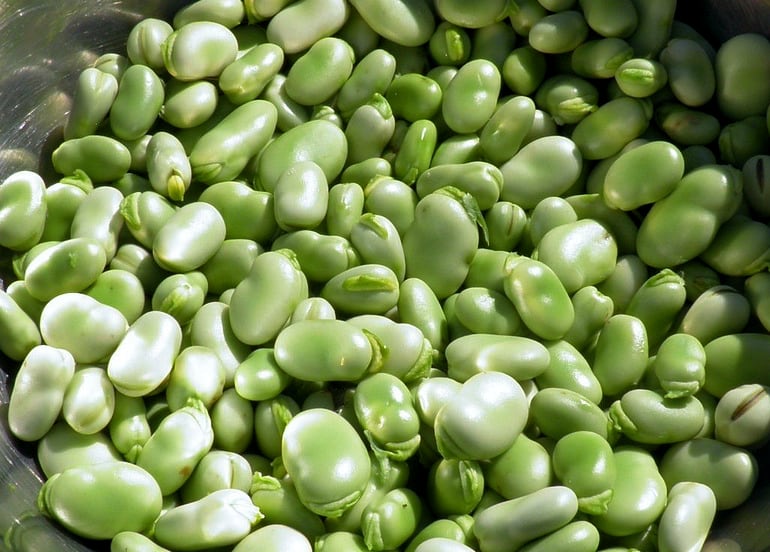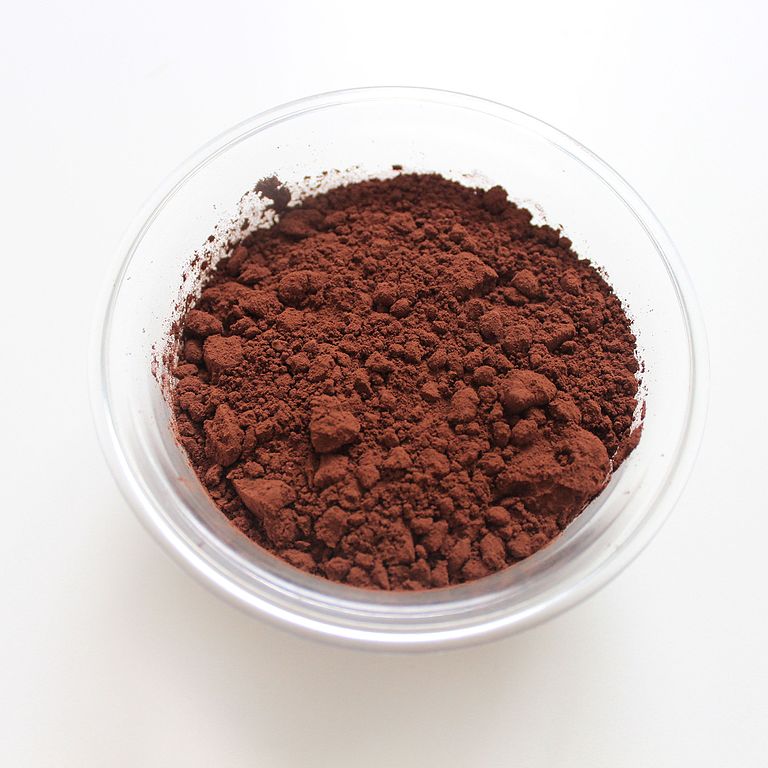Fava Bean vs. Cocoa Powder
Nutrition comparison of Cooked Fava Bean and Cocoa Powder
Ever wonder how your favorite foods stack up against each other in terms of nutrition?
We compared the nutritional contents of
cooked
fava bean
versus
cocoa powder
(100g each)
below using 2020 USDA and NIH data[1].
For a quick recap of significant nutrients and differences in fava bean and cocoa powder:
- Both cocoa powder and fava bean are high in calories, dietary fiber and potassium.
- Cocoa powder has more riboflavin and niacin, however, fava bean contains more folate.
- Cocoa powder is an excellent source of calcium, iron and protein.
USDA sources for nutritional information: Fava Bean (Broadbeans (fava beans), mature seeds, cooked, boiled, without salt) and Cocoa Powder (Cocoa, dry powder, unsweetened) . Have a correction or suggestions? Shoot us an email.
Calories and Carbs
calories
Both cocoa powder and fava bean are high in calories. Cocoa powder has 107% more calories than fava bean - cocoa powder has 228 calories per 100 grams and fava bean has 110 calories.
For macronutrient ratios, fava bean is heavier in protein, heavier in carbs and much lighter in fat compared to cocoa powder per calorie. Fava bean has a macronutrient ratio of 27:70:3 and for cocoa powder, 18:53:29 for protein, carbohydrates and fat from calories.
Macro Ratios from Calories:
| Fava Bean | Cocoa Powder | |
|---|---|---|
| Protein | 27% | 18% |
| Carbohydrates | 70% | 53% |
| Fat | 3% | 29% |
| Alcohol | ~ | ~ |
carbohydrates
Cocoa powder is high in carbohydrates and fava bean has 66% less carbohydrates than cocoa powder - cocoa powder has 57.9g of total carbs per 100 grams and fava bean has 19.7g of carbohydrates.
dietary fiber
Both cocoa powder and fava bean are high in dietary fiber. Cocoa powder has 585% more dietary fiber than fava bean - cocoa powder has 37g of dietary fiber per 100 grams and fava bean has 5.4g of dietary fiber.
sugar
Cocoa powder and fava bean contain similar amounts of sugar - cocoa powder has 1.8g of sugar per 100 grams and fava bean has 1.8g of sugar.
Protein
protein
Cocoa powder is an excellent source of protein and it has 158% more protein than fava bean - cocoa powder has 19.6g of protein per 100 grams and fava bean has 7.6g of protein.
Fat
saturated fat
Cocoa powder is high in saturated fat and fava bean has 99% less saturated fat than cocoa powder - cocoa powder has 8.1g of saturated fat per 100 grams and fava bean has 0.07g of saturated fat.
Vitamins
Vitamin C
Fava bean and cocoa powder contain similar amounts of Vitamin C - fava bean has 0.3mg of Vitamin C per 100 grams and cocoa powder does not contain significant amounts.
Vitamin A
Fava bean and cocoa powder contain similar amounts of Vitamin A - fava bean has 1ug of Vitamin A per 100 grams and cocoa powder does not contain significant amounts.
Vitamin E
Cocoa powder and fava bean contain similar amounts of Vitamin E - cocoa powder has 0.1mg of Vitamin E per 100 grams and fava bean has 0.02mg of Vitamin E.
Vitamin K
Cocoa powder and fava bean contain similar amounts of Vitamin K - cocoa powder has 2.5ug of Vitamin K per 100 grams and fava bean has 2.9ug of Vitamin K.
The B Vitamins
Cocoa powder has more riboflavin and niacin, however, fava bean contains more folate. Both fava bean and cocoa powder contain significant amounts of thiamin, pantothenic acid and Vitamin B6.
| Fava Bean | Cocoa Powder | |
|---|---|---|
| Thiamin | 0.097 MG | 0.078 MG |
| Riboflavin | 0.089 MG | 0.241 MG |
| Niacin | 0.711 MG | 2.185 MG |
| Pantothenic acid | 0.157 MG | 0.254 MG |
| Vitamin B6 | 0.072 MG | 0.118 MG |
| Folate | 104 UG | 32 UG |
Minerals
calcium
Cocoa powder is an excellent source of calcium and it has 256% more calcium than fava bean - cocoa powder has 128mg of calcium per 100 grams and fava bean has 36mg of calcium.
iron
Cocoa powder is an excellent source of iron and it has 824% more iron than fava bean - cocoa powder has 13.9mg of iron per 100 grams and fava bean has 1.5mg of iron.
potassium
Both cocoa powder and fava bean are high in potassium. Cocoa powder has 469% more potassium than fava bean - cocoa powder has 1524mg of potassium per 100 grams and fava bean has 268mg of potassium.
Antioxidants and Phytonutrients
Omega-3 and Omega-6
omega 6s
Comparing omega-6 fatty acids, cocoa powder has more linoleic acid than fava bean per 100 grams.
| Fava Bean | Cocoa Powder | |
|---|---|---|
| linoleic acid | 0.152 G | 0.44 G |
| Total | 0.152 G | 0.44 G |
Customize your serving size
The comparison below is by common portions, e.g. cups, packages. You can also see a more concrete comparison by weight at equal weight (by grams) comparison.
Note: The specific food items compared are: Fava Bean (Broadbeans (fava beans), mature seeds, cooked, boiled, without salt) and Cocoa Powder (Cocoa, dry powder, unsweetened) .
Cooked Fava Bean g
()
|
Daily Values (%) |
Cocoa Powder g
()
|
|||||
|---|---|---|---|---|---|---|---|
| KCAL % |
|
5% | calories | 5% |
|
KCAL % | |
| G % |
|
5% | carbohydrates | 5% |
|
G % | |
| G % |
|
5% | dietary fiber | 5% |
|
G % | |
| G | 5% | sugar | 5% | G | |||
| G % |
|
5% | total fat | 5% |
|
G % | |
| G % |
|
5% | saturated fat | 5% |
|
G % | |
| G | 5% | monounsaturated fat | 5% | G | |||
| G | 5% | polyunsaturated fat | 5% | G | |||
| G | 5% | trans fat | 5% | G | |||
| MG | 5% | cholesterol | 5% | MG | |||
| MG % |
|
5% | sodium | 5% |
|
MG % | |
| 5% | Vitamins and Minerals | 5% | |||||
| UG % |
|
5% | Vitamin A | 5% |
|
UG % | |
| MG % |
|
5% | Vitamin C | 5% |
|
MG % | |
| IU % |
|
5% | Vitamin D | 5% |
|
IU % | |
| MG % |
|
5% | calcium | 5% |
|
MG % | |
| MG % |
|
5% | iron | 5% |
|
MG % | |
| MG % |
|
5% | magnesium | 5% |
|
MG % | |
| MG % |
|
5% | potassium | 5% |
|
MG % | |
| MG % |
|
5% | thiamin (Vit B1) | 5% |
|
MG % | |
| MG % |
|
5% | riboflavin (Vit B2) | 5% |
|
MG % | |
| MG % |
|
5% | niacin (Vit B3) | 5% |
|
MG % | |
| MG % |
|
5% | Vitamin B6 | 5% |
|
MG % | |
| MG % |
|
5% | pantothenic acid (Vit B5) | 5% |
|
MG % | |
| UG % |
|
5% | folate (Vit B9) | 5% |
|
UG % | |
| UG % |
|
5% | Vitamin B12 | 5% |
|
UG % | |
| MG % |
|
5% | Vitamin E | 5% |
|
MG % | |
| UG % |
|
5% | Vitamin K | 5% |
|
UG % | |
| G % |
|
5% | protein | 5% |
|
G % | |
| UG % |
|
5% | biotin (Vit B7) | 5% |
|
UG % | |
| MG % |
|
5% | choline | 5% |
|
MG % | |
| MG % |
|
5% | chlorine | 5% |
|
MG % | |
| UG % |
|
5% | chromium | 5% |
|
UG % | |
| MG % |
|
5% | copper | 5% |
|
MG % | |
| UG % |
|
5% | fluoride | 5% |
|
UG % | |
| UG % |
|
5% | iodine | 5% |
|
UG % | |
| MG % |
|
5% | manganese | 5% |
|
MG % | |
| UG % |
|
5% | molybdenum | 5% |
|
UG % | |
| MG % |
|
5% | phosphorus | 5% |
|
MG % | |
| UG % |
|
5% | selenium | 5% |
|
UG % | |
| MG % |
|
5% | zinc | 5% |
|
MG % | |
| G | 5% | Water | 5% | G | |||
| G | 5% | Starch | 5% | G | |||
| G | 5% | Alcohol | 5% | G | |||
FAQ
Does cocoa powder or fava bean contain more calories in 100 grams?Both cocoa powder and fava bean are high in calories. Cocoa powder has 110% more calories than fava bean - cocoa powder has 228 calories in 100g and fava bean has 110 calories.
Does cocoa powder or fava bean have more carbohydrates?
By weight, cocoa powder is high in carbohydrates and fava bean has 70% fewer carbohydrates than cocoa powder - cocoa powder has 57.9g of carbs for 100g and fava bean has 19.7g of carbohydrates.
Does cocoa powder or fava bean contain more calcium?
Cocoa powder is a rich source of calcium and it has 260% more calcium than fava bean - cocoa powder has 128mg of calcium in 100 grams and fava bean has 36mg of calcium.
Does cocoa powder or fava bean contain more iron?
Cocoa powder is an abundant source of iron and it has 820% more iron than fava bean - cocoa powder has 13.9mg of iron in 100 grams and fava bean has 1.5mg of iron.
Does cocoa powder or fava bean contain more potassium?
Both cocoa powder and fava bean are high in potassium. Cocoa powder has 470% more potassium than fava bean - cocoa powder has 1524mg of potassium in 100 grams and fava bean has 268mg of potassium.

